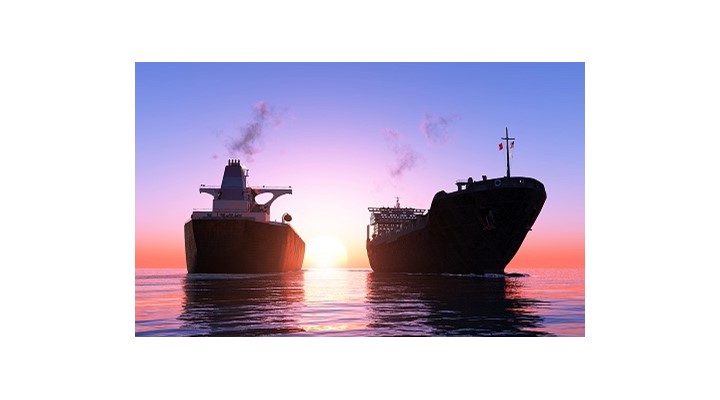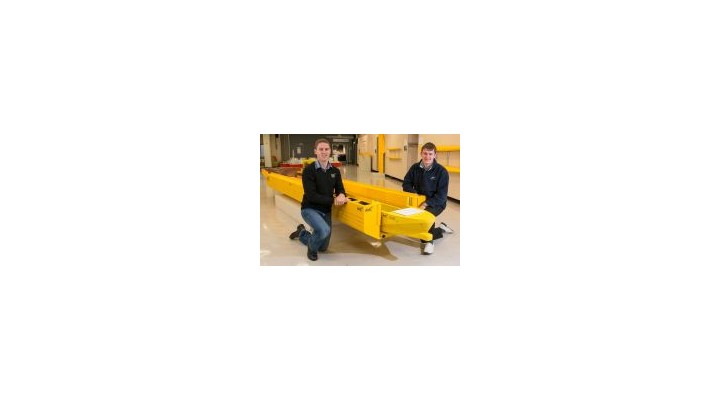Traditional transhipment involves an export vessel, such as a Capesize bulk carrier, mooring as close to the mining operation as its draught allows and being loaded by smaller feeder vessels.
This project looks at using a floating harbour transhipper (FHT) that acts as an 'offshore warehouse' to meet the growing demands for coastal transhipment in the mining sector and commercial port operations.
PhD candidates Nick Johnson and Lauchlan Clarke are working with industry partner Sea Transport Corporation (STC) to refine and test the FHT concept, which is the first of its kind in the world. The three-year project has received a $420,000 Linkage grant from the Australian Research Council and STC.
"Transhipping is about transferring large volumes of cargo as quickly and cheaply as possible from remote areas with limited infrastructure in as wide a range of weather conditions as possible," Johnson said.
"Traditionally, the transfer of bulk ore cargo takes place over a couple of weeks, with the feeder vessels running back and forth between a small port and the moored export vessel.
"The difference with what we're looking at is the FHT will act as an offshore warehouse, allowing the feeder vessels and export vessel to work on their own continuous schedules."
Design challenges
The FHT, estimated to be worth around US$90 million, is approximately 315-metres long and features an enclosed conveyor system to facilitate the transfer of the bulk product from the feeder vessel into its own stockpile, and from this stockpile to the export vessel.
Using an enclosed conveyor system eliminates spillage and allows for dust-free transhipment, reducing impact on the surrounding environment and any nearby residential areas.
The FHT system aims to significantly reduce transhipment delays caused by inclement weather by greatly reducing the relative motions between the FHT and the feeder vessel. This is achieved by mooring the feeder vessel inside a well dock at the aft end of the FHT, rather than the side-by-side method used in traditional transhipping.
Johnson is researching the operational limits of the system and quantifying the sea states in which it can operate.
"The feeder vessel is sheltered inside the FHT well dock and my job is to calculate the sea states in which it can dock and leave the dock, and whether there are scenarios where it should stay in dock until it is safe to leave," he said.
I'm also looking at the limiting sea states to transfer goods from the FHT to the export vessel when they're moored to each other."
This scenario-modelling work will be completed on computer in tandem with rigorous physical experimental testing in AMC's model test basin.
Clarke 's area of research focuses on the water flow that is produced when the feeder vessel enters or exits the FHT well dock.
"The well dock is always open to the ocean, and when the feeder vessel enters, the majority of the water in the well dock has to be displaced. I'll be looking at innovative solutions to minimise any negative effects on the manoeuvrability of the feeder vessel, such as using vents to allow the water to escape the well dock as the feeder vessel enters," Clarke said.
"As soon as you've got water moving in a very enclosed area like that, the interaction between the structures is massive and to understand something about the science of that will be challenging. I'm using a numerical technique called smoothed particle hydrodynamics, which is a relatively undeveloped technique that hasn't been applied to anything like this before, so it's a novel approach to a novel problem."
The project has huge potential to minimise the environmental impact of bulk product export (such as iron ore, bauxite, coal and grain) and save billions of dollars in onshore infrastructure costs thanks to offshore warehousing.
It eliminates the need for major dredging and earthworks to enable access to coastal ports, and has generated a great deal of interest among mining companies around the world.







